Article by Mistress Francesca Cellini, Baron François du Guyon and TH Baroness Ceara Shionnach.
History of the Good Food Feast
From 1995 (and for all but one year of Baron Stephen Aldred’s tenure), Politarchopolis and Saint-Florian-de-la-rivière competed in a fine food contest. In July 1995, the cooks known as the Politarchopolan Assault Catering Corp (PACC) ran the very first Good Food Feast (GFF), aimed at being a replica of a 15th century wealthy Italian noble family dinner. The intent was to provide food which was the best ever offered to a feast in Lochac with a suitable atmosphere to match. The PACC also wanted to push back the boundaries of what was considered possible to provide in a feast. That first Good Food Feast achieved the level and quality of food and entertainment which is now (in 2015) considered the norm.
On Saturday 18 July 2015, the PACC ran another GFF in honour of the twentieth anniversary of the original event. It was held in the Barony of Politarchopolis at St Margaret’s Uniting Church Hall in Hacket, ACT, Australia. The event was booked out, attracting 66 guests comprising both members of the Barony as well as visitors from other groups in Lochac.
Research for the Good Food Feast 2015
The concept underpinning the Good Food Feast is fine dining, rather than bulk catering. Therefore, the menu includes dishes which are rarely (if ever seen) at a normal event due to their cost and complexity.
Although the first GFF used Italian dining as its basis, the culinary theme of the Southern Mediterranean regions are a relatively common basis for events these days. So, in order to again push the culinary envelope, this event’s menu, style, and decoration was instead focused on the 16th century Low Countries (see the map below). This is not a usual regional theme, and part of the reason for the choice was to provide a challenge to the PACC members who have catered events ranging in size from 40 guests to 320 and in styles from ancient Roman to high Italian Renaissance and Elizabethan.

The theme was ‘Creation’. The menu, display, decoration, and entertainment aligned with the first account of the creation of the heavens and the earth in the Book of Genesis:
- day one divides the darkness from light,
- day two divides the “waters above” from the “waters below”,
- day three divides the sea from the land,
- day four sees population of the darkness and light with sun, moon and stars,
- day five sees the population of the seas and skies with fish and fowl, and
- day six sees the population of the land with land-based creatures and humankind.
The event was about creating the ambience of a feast as whole, not just the meal. The service, dressing of the hall and tables as well as the entertainments, was designed to create a moment of what was once an everyday occurrence in the height of renaissance Europe.
The recipe sources included, but were not limited to:
Sabina Welser’s Cookbook; Translated from Das Kochbuch der Sabina Welserin (c. 1553) by Valoise Armstrong; 1998. Also Hugo Stopp’s edition of the cookbook of Sabin Welserin, Augsburg (c. 1553) from Universitätsverlag C. Winter Heidelberg (ISBN: 3-8253-2905-4, DM 20,–). Electronic version accessed 12 December 2014, from:
http://www.staff.uni-giessen.de/gloning/tx/sawe.htm This is the earliest known cook book by a woman.
Een nieuw zuidnederlands kookboek uit de vijftiende eeuw. Scripta 17. (A new southern Dutch cook book from the fifteenth century); retrieved from Coquinaria 2 January 2015 from: http://www.coquinaria.nl/kooktekst/Edelikespijse2.htm
Ein Buch von gutter spise; Translation by Alia Atlas; 1993; retrieved 25 January 2015 from: http://www.medievalcookery.com/etexts/buch.html The book of good food has been written around 1350 in Würzburg and is the oldest collection of German Cooking Recipes known (in possession of the University Library in Munich) in the form of a parchment manuscript which was make the Episcopal Protonar Michael de Leone.
Wel ende edelike spijse (Good and Noble Food); Manuscript UB Gent 1035 – Chapter II (recipes 2.1/2.29); retrieved from Coquinaria 2 January 2015 from: http://www.coquinaria.nl/kooktekst/Edelikespijse2.htm
Koge Bog: Indeholdendis et hundrede fornødene stycker/ Som ere/om Brygning/Bagning/ Kogen/Brændevijn oc Miød at bere-de/saare nytteligt vdi Husz holdning/&c. Som tilforn icke paa vort Danske Sprock vdi Tryck er vdgaaen. Prentet i Kiøbenhaffn/Aff Salomone Sartorio/1616. Cook book: Containing A hundred useful pieces, Which are about brewing, baking, Cooking, aquavit and mead to make, As is useful in house Holding &c. Which before not in our Danish Language is issued in print. Printed in Copenhagen, by Salomone Sartorio, 1616. Retrieved 8 November 2014: http://forest.gen.nz/Medieval/articles/cooking/1616.html
The Dutch Eenen Nyeuwen Coock Boeck (1560), written by Gheeraert Vorselman and translated by Lord Floris van Montfort (G.A. van heusden) of the Shire of Polderslot.
Politarchopolan Assault Catering Corp (PACC)
The PACC is a long-standing group of experienced cooks who often come together to prepare feasts in the Barony of Politarchopolis. They are the ones who coined the common motto of Politarchopolis: “Eat, eat, you’re all too thin”.
The group includes:
- Lady Adeline of the Welsh,
- Baroness Anne de Tournais,
- Don Diccon Shorthand,
- Mistress Francesca Cellini,
- Don François Henri du Guyon,
- Baroness Gertrud von Ritzebuttel,
- Mistress Kiriel du Papillon, and
- Mistress Monique de la Maison Rouge.
Wait Staff
For a much-reduced event fee, 18 volunteers worked hard all night as event staff. From carrying items for the guests, hanging up coats and washing the hands of the guests with scented water, to serving food and drinks, washing feasting gear many times and catering to the whims of the guests, the wait staff did an exceptional job of making guests feel like high nobility. The wait staff had all agreed to just be “servers” for the night. A strict rule was that there was to be no familiarity with the guests. This formality surprised some of the guests (who wanted to engage in discussion and banter with their friends), and entertained the wait staff themselves. Each of the wait staff wore a red and white tabard that had the golden, winged cornucopia badge of the PACC on the sleeve. Before the feast started, the wait staff got to try a selection of the dishes to be served during the night (during their staff meal), so that not only were they not serving on empty stomachs, but they were able to explain to the guests the dish and its ingredients (particularly for those with allergies).
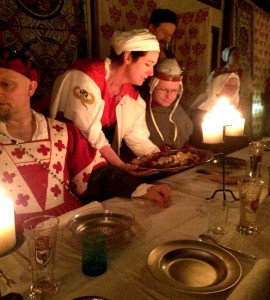
Blow-by-blow of the Good Food Feast 2015
Imagine the ultimate feast. A feast where, from the moment you enter, you are treated like royalty. Your basket carried for you, dishes washed between courses, glass kept filled, plate filled to over flowing with the finest food cooked by some of the most lauded chefs of Lochac.
The PACC team spent a year planning and preparing for the event, and it showed in the huge amount of detail and effort that was evident.
From the moment they arrived, guests were treated like high nobility. Guests entered along a path lined with colourful pennants and through a coat room where members of the event staff hung your coat up for you, carried your feasting gear and personal items and directed you to your pre-allocated seating in the darkened hall.
More wait staff presented you almost immediately with a bowl with which you put your hands over to have them washed in fragrant water and dried your hands with a hand towel.
At each seating place sat a special-painted glass that included the winged cornucopia badge of the PACC and the griffin of Politarchopolis, a napkin, a pewter spoon and a metal plate. Guests were delighted to find out that they were able to keep said items as feast mementos.
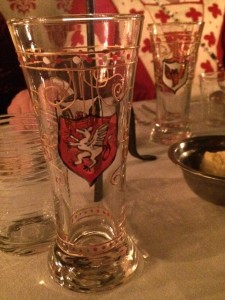
The hall itself was absolutely covered in beautiful decorations. White wall hangings with red floral motifs covered every wall and blue hangings with white stars were draped across the entire ceiling. Wooden candelabra hung below the wall hangings, providing soft light upon all.

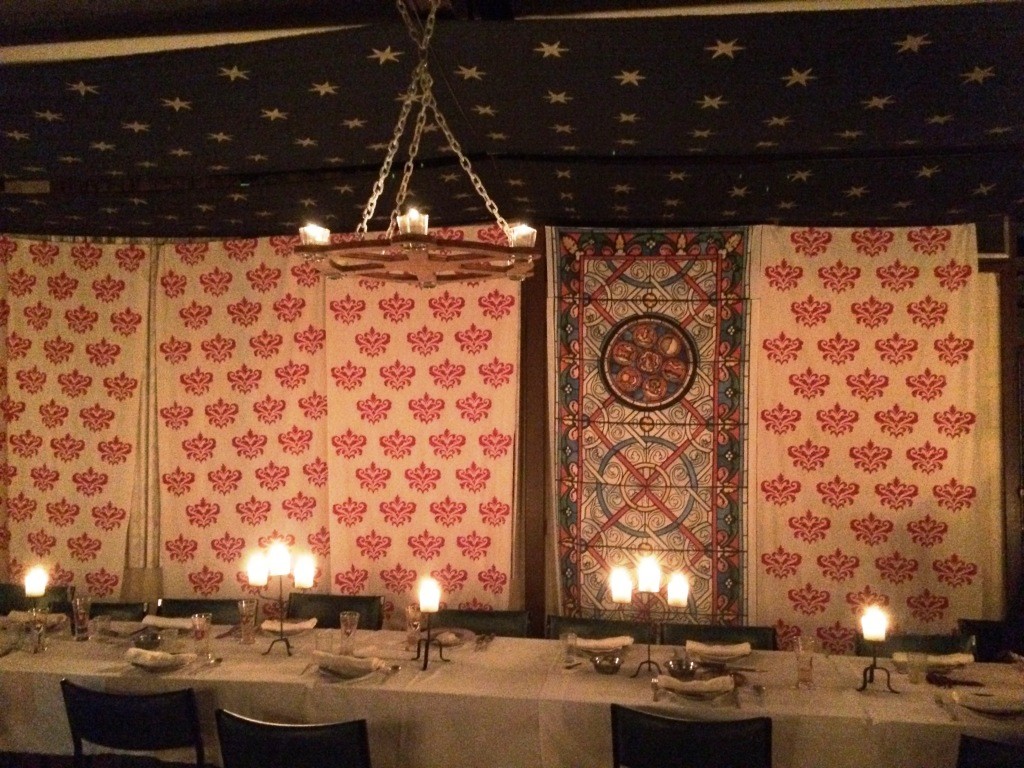
In one corner of the hall there was a display cabinet with colourful majolica plates – in the opposite corner, three musicians played and sung medieval music.
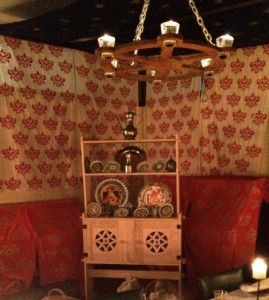
In the bathroom, guests were greeted by a cornucopia of hand crafted medieval soaps by the sinks in the bathrooms.
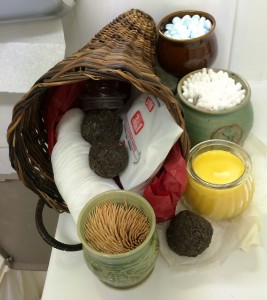
To open the feast, Baron François Henri Guyon spoke words from Genesis the Vulgate Latin Bible – first in Latin and followed by the English translation:
“in principio creavit Deus caelum et terram
terra autem erat inanis et vacua et tenebrae super faciem abyssi et spiritus Dei ferebatur super aquas
dixitque Deus fiat lux et facta est lux”
“In the beginning God created heaven, and earth.
And the earth was void and empty, and darkness was upon the face of the deep; and the spirit of God moved over the waters.
And God said: Be light made. And light was made.
The Politarchopolitan Assault Catering Corps welcomes you all to the Good Food Feast.
Tonight’s theme is the Creation.
LET THERE BE LIGHT.”
Upon the final words, wait staff entered the hall with tapers and lit the candles on each of the tables, bringing light to the hall.
A short while later, the second part of Genesis was spoken by Baron François:
“dixit quoque Deus fiat firmamentum in medio aquarum et dividat aquas ab aquis
et fecit Deus firmamentum divisitque aquas quae erant sub firmamento ab his quae erant super firmamentum et factum est ita”
“And God said: Let there be a firmament made amidst the waters: and let it divide the waters from the waters.
And God made a firmament, and divided the waters that were under the firmament, from those that were above the firmament, and it was so.
And with division of waters came drink. The Butlers will supply you all according to your needs.”
Butlers and wait staff walked glass flasks of various beverages around the room, including: beer, white wine, red wine, hippocras (spiced wine), lemon and ginger cordial, elderberry cordial and water.
Baron François introduced the first course with some more lines from Genesis:
“et ait germinet terra herbam virentem et facientem semen et lignum pomiferum faciens fructum iuxta genus suum cuius semen in semet ipso sit super terram et factum est ita
et protulit terra herbam virentem et adferentem semen iuxta genus suum lignumque faciens fructum et habens unumquodque sementem secundum speciem suam et vidit Deus quod esset bonum
And he said: let the earth bring forth green herb, and such as may seed, and the fruit tree yielding fruit after its kind, which may have seed in itself upon the earth. And it was so done.
And the earth brought forth the green herb, and such as yieldeth seed according to its kind, and the tree that beareth fruit, having seed each one according to its kind. And God saw that it was good.
Here are vegetables and herbs. The tongue is in remembrance of the word.”
Out came the wait staff again, demure and professional, with plates of the first course:
- quail eggs stuffed with a delicately spiced herb mash,
- smoked pressed beef tongue,
- pickled vegetables – honey and saffron covered kohlrabi, turnip, parsnip and carrots, and
- freshly baked bread.
The knots of fresh bread were served on what looked like wooden swords, which was a novelty in itself.
Later, the second course was introduced:
“dixit etiam Deus producant aquae reptile animae viventis et volatile super terram sub firmamento caeli
creavitque Deus cete grandia et omnem animam viventem atque motabilem quam produxerant aquae in species suas et omne volatile secundum genus suum et vidit Deus quod esset bonum”
“God also said: let the waters bring forth the creeping creature having life, and the fowl that may fly over the earth under the firmament of heaven.
And God created the great whales, and every living and moving creature, which the waters brought forth, according to their kinds, and every winged fowl according to its kind. And God saw that it was good.
Here are the fish and fowl for your enjoyment.
Excellencies all, here is the Politarchopolitan Assault Catering Corps’ first presentation piece.
A great fish.”
Before the second course came out, an enormous carved wooden and metal fish was carried around the hall, with wait staff proceeding and following it waving blue organza to represent the waves of the sea. After being presented to the guests, the fish was placed on the centre serving table and opened to present the salmon part of the second course.

The second course included:
- baked salmon on rye scales of pastry,
- spinach cooked in the Hungarian manner,
- oysters served on flowers of lemon,
- goose with green garlic sauce, and
- golden scallops.
The golden scallops were a delightful soteltie of crisp sugar paste scallop shells with an almond milk jelly and some marzipan.
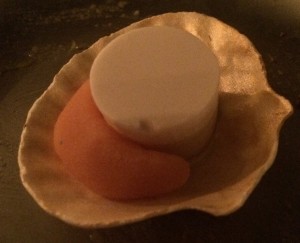
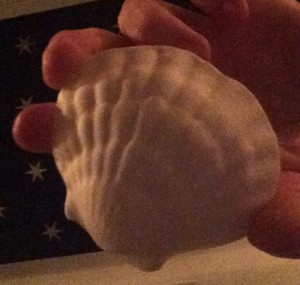
At the end of the second course, guests were lead outside for an entertaining puppet show written and performed by Mistress Rowan Perigrynne and Lord Nicodemus Novello. The story told was of Earl Leofric and his wager with Lady Godiva that had her ride naked through the streets of Coventry. The play was well received and elicited many laughs from the crowd from jokes aplenty referencing medieval, SCA and mundane events.
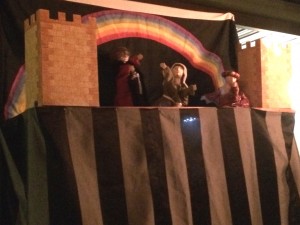
When the play was over, guests quickly returned to the warmth of the hall to find that all of their plates, glassware and cutlery had been stealthily washed by the wait staff.
The third course was introduced with the next lines from Genesis:
“dixit quoque Deus producat terra animam viventem in genere suo iumenta et reptilia et bestias terrae secundum species suas factumque est ita”
“And God said: Let the earth bring forth the living creature in its kind, cattle and creeping things, and beasts of the earth, according to their kinds. And it was so done.
Excellencies all, the beasts of the earth!
My Lords and Ladies – the great beast!”
This time, wait staff walked out a spit roast calf and sat it on the middle table. A Seer was brought out to read the calf’s entrails (white sausages) – a nod to the first GFF, which included a Seer reading the entrails of the suckling pig. The Seer was asked a number of questions, including whether winter was ending (no), and how long the king will live (maybe until Yule, at least).
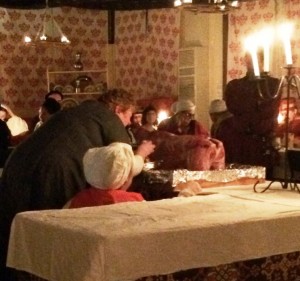
Third course consisted of:
- veal,
- small bird pies of quail and pigeon with bacon, grapes and sweet white wine,
- pickled cabbage,
- white sausages,
- beetroot,
- peas on a skewer, and
- a carrot, almond and violet mash.

At the conclusion of the third course, guests were again invited outside for the next entertainment. Whilst the guests were being served warmed apple juice, Mistress Kiriel du Papillon directed a Tableaux of three scenes.
The first scene was about the story Herodias, who ordered for John the Baptist’s head to be delivered to her on a plate.
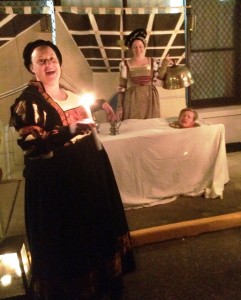
The second scene was one of Adam and Eve being tempted in the Garden of Eden. During this tableaux, the pomegranate being held by Eve was opened to produce small candy seeds, which were distributed to the guests. Who knew knowledge could taste so good!
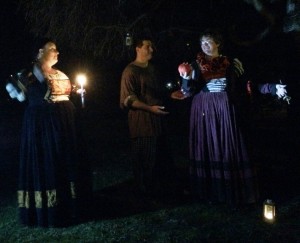
The third and final scene was that of youth and old age. The moral of the story was that youth and beauty fades, whereas old age and money equalled security. At the end of this scene, the old man and the young woman distributed gold coins of crisp sugarplate to the guests. Afterwards, guests returned to the hall to find their feasting gear washed once again.


Baron François spoke one last time to introduce the fourth and final course – dessert:
“Excellencies, the sweet desserts.
Excellencies all, the Politarchopolitan Assault Catering Corps’ final presentation piece.
Many great works were created for tonight: Don Lorcan carved the great fish; Mistress
Francesca created the wall hangings; I created the Ambry; Lord Sven the Dishes and spoons;
Baroness Gertrude cooked the meals; and Mistress Monique de la Maison Rouge created
these plates.
But art is ephemeral. It exists only tonight, for you, and in your memories and your tales to
those not here.”
As Baron François spoke, two large presentation pieces were walked around the hall as each guest was handed a small version of their own; painted, majolica-style plates. When he finished speaking, Mistress Monique smashed the two large plates onto the central tables. For the plates represented more sotelties – plates made of a base of sugar paste and fondant painted with food dyes. Each of the plates were styled on period images.
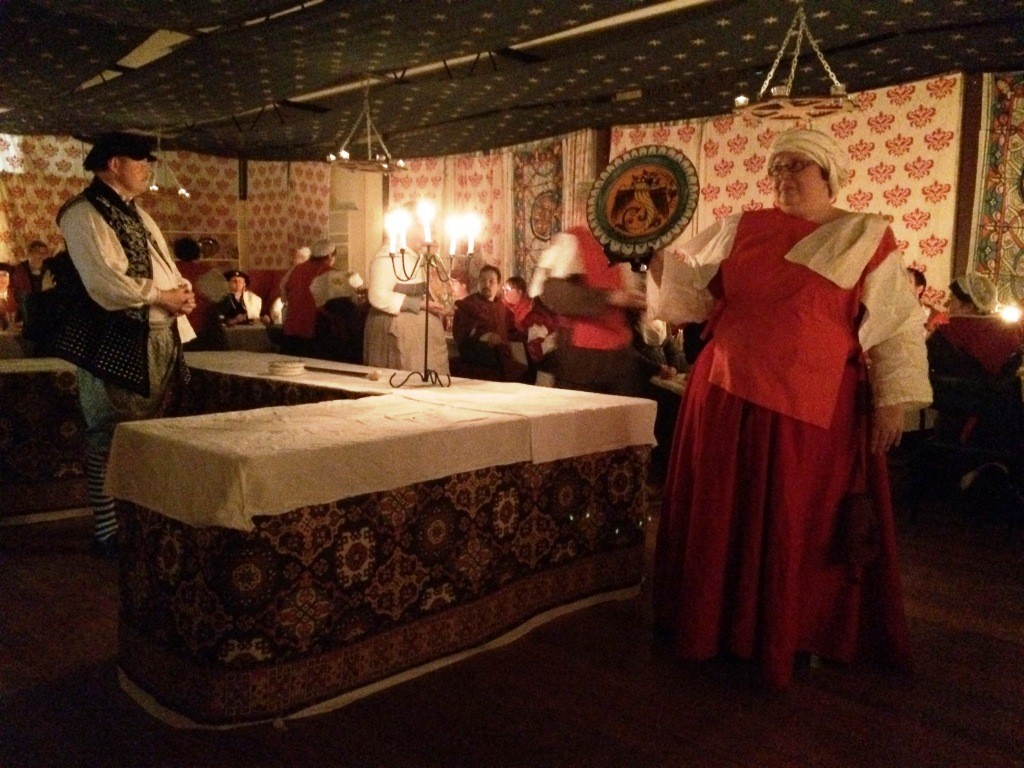
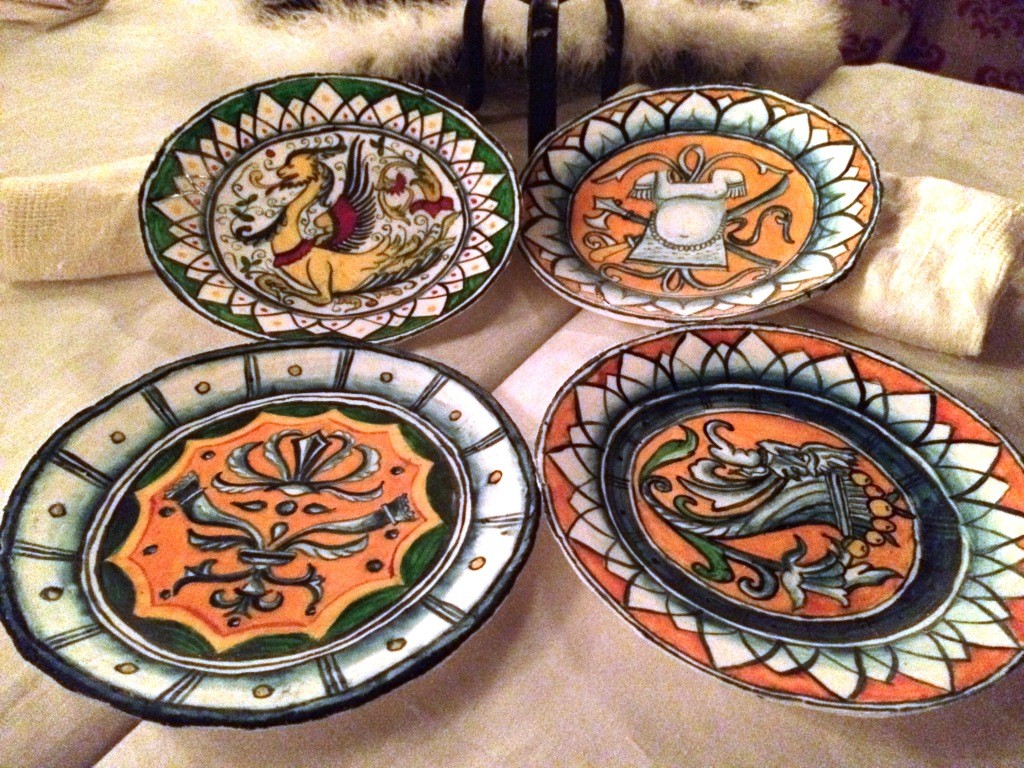

Shards of the smashed, larger plates were distributed around the guests for consumption so that the smaller plates could be taken home as a delicious memento of the feast.
The dessert course also included:
- A rich plum tart of dried plums plumped with red wine and cinnamon and tucked into a soft blanket of custard,
- A Malavosia Pear tart with caramelised pear slices and a luscious sweet wine glaze,
- Spanish pastry pillows of sweet almond and butter layered pastry, and
- Hand-made Politarchopolan cheeses with crisp Gouda biscuits.
The event was well received and was a unique, once-in-a-lifetime experience for attendees to feel like high nobility in a fine dining, 16th century Low Countries style.
When the event finally ended at 11pm, guests were surprised at the time of evening. Guests enjoyed the evening so much that they did not leave for another 45 minutes, talking amongst themselves about the event, and finally being able to greet their friends who were the wait staff.
